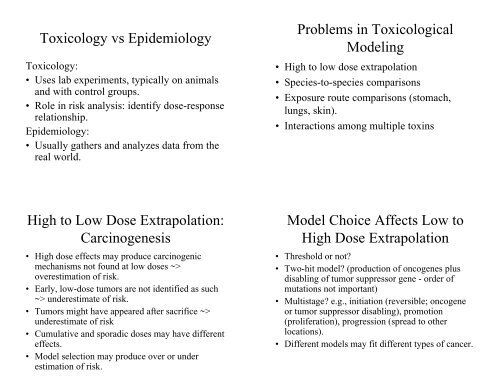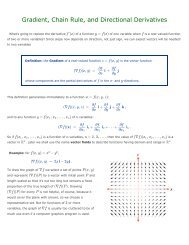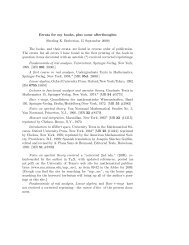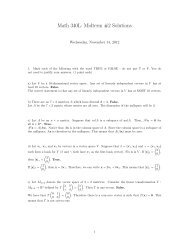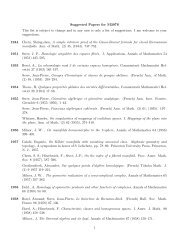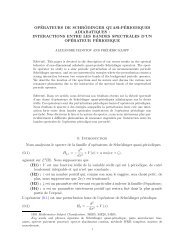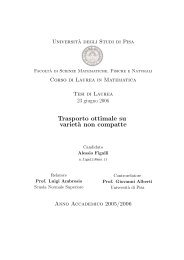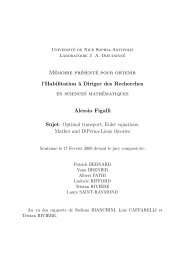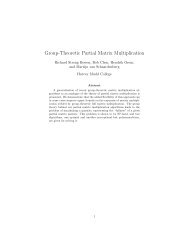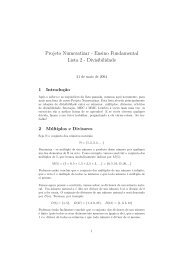Toxicology and Epidemiology
Toxicology and Epidemiology
Toxicology and Epidemiology
You also want an ePaper? Increase the reach of your titles
YUMPU automatically turns print PDFs into web optimized ePapers that Google loves.
<strong>Toxicology</strong> vs <strong>Epidemiology</strong><br />
<strong>Toxicology</strong>:<br />
• Uses lab experiments, typically on animals<br />
<strong>and</strong> with control groups.<br />
• Role in risk analysis: identify dose-response<br />
relationship.<br />
<strong>Epidemiology</strong>:<br />
• Usually gathers <strong>and</strong> analyzes data from the<br />
real world.<br />
High to Low Dose Extrapolation:<br />
Carcinogenesis<br />
• High dose effects may produce carcinogenic<br />
mechanisms not found at low doses ~><br />
overestimation of risk.<br />
• Early, low-dose tumors are not identified as such<br />
~> underestimate of risk.<br />
• Tumors might have appeared after sacrifice ~><br />
underestimate of risk<br />
• Cumulative <strong>and</strong> sporadic doses may have different<br />
effects.<br />
• Model selection may produce over or under<br />
estimation of risk.<br />
Problems in Toxicological<br />
Modeling<br />
• High to low dose extrapolation<br />
• Species-to-species comparisons<br />
• Exposure route comparisons (stomach,<br />
lungs, skin).<br />
• Interactions among multiple toxins<br />
Model Choice Affects Low to<br />
High Dose Extrapolation<br />
• Threshold or not?<br />
• Two-hit model? (production of oncogenes plus<br />
disabling of tumor suppressor gene - order of<br />
mutations not important)<br />
• Multistage? e.g., initiation (reversible; oncogene<br />
or tumor suppressor disabling), promotion<br />
(proliferation), progression (spread to other<br />
locations).<br />
• Different models may fit different types of cancer.
Species to Species Comparison<br />
• Different body weights have different<br />
metabolisms, which may affect processing of<br />
toxins.<br />
• Mechanisms <strong>and</strong> target organs or tissues may not<br />
be analogous.<br />
• Use of homogeneous <strong>and</strong> highly susceptible test<br />
animals is necessary to obtain a detectable<br />
response <strong>and</strong> produce health-conservative risk<br />
estimates, but this may inflate cancer rates.<br />
Problems with Epidemiological<br />
Studies<br />
1. Can not address cause <strong>and</strong> effect<br />
• No control group<br />
• Confounding variables (appropriate analysis<br />
helps somewhat)<br />
2. Measurement error<br />
• Self-report may be necessary<br />
• Estimates, averages, or surrogates may be<br />
necessary.<br />
Reasons for High-Dose<br />
Toxicological Assessments<br />
• Modeling provides information about possibilities. (e.g., if<br />
cost estimates for remediation vary by several orders of<br />
magnitude, but all are low, the choice of action is clear.)<br />
• Modeling provides information about which assumptions<br />
are most important <strong>and</strong> highlights where more research can<br />
be most useful.<br />
• Can address causality by using control groups.<br />
• Experiments with small doses need large numbers of<br />
animals, which is prohibitively expensive. (High dose<br />
studies may cost $1 - 5 million.)<br />
• Experiments with humans are unethical.<br />
Problems with Epidemiological<br />
Studies, Continued<br />
3. Extrapolation<br />
• Population studied may have higher<br />
exposure than general population<br />
• Population studied may not be<br />
representative of general population (health,<br />
age, etc.)<br />
4. Interpreting small effects (e.g., RR < 2)


